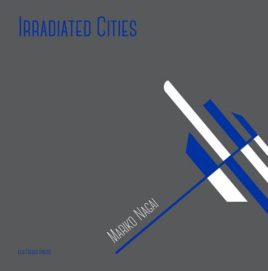 Mariko Nagai
Mariko Nagai
Les Figues Press ($17)
by John Bradley
"we are still in the before the after : before the before the after," writes Mariko Nagai, reflecting on the nuclear disaster that took place in Fukushima in 2011. The nuclear focus of this book-on Hiroshima, Nagasaki, Tokyo, and Fukushima-feels quite timely, given our nation's stance on North Korea, which means it makes for uncomfortable reading, as it should. The book, with both its prose and photographs, is quietly and chillingly effective.
Not only the topic, but the consequences of nuclear warfare confront the reader here. Take this description of a victim of the Hiroshima bomb: "something is dismantling him from within : hair keeps coming out in fistfuls, & he is sleeping more : bloody nose & erupting ulcers on his lips : he cannot keep anything inside his body & lies there in his own vomit & diarrhea : things are breaking down inside, the body is collapsing from inside out & they don't know what it is . . . ." The use of the colons, as can be seen, blurs cause and effect. Everything is connected to everything else. Nagai uses the colons this way in all of the thirty-two prose poems in the book, even for the closing. There's never a period to provide closure, even at the very end of each piece. The colon is the perfect punctuation for this book, as it's logical, neutral, and inevitable.
This punctuation usage creates a challenge to the reader, however, as each piece (usually a page long) must be read without pausing. Nagai holds the reader's attention, though, with her shifts in tone and voice. In the piece on the Japanese fishermen irradiated by an American bomb detonated in the Pacific during a test on March 1, 1954, for example, the author weaves in this statement from Edward Teller, dismissing the death of a fisherman: "it is not from radiation, but from underlying liver cirrhosis compounded by an infection : it is unreasonable to make such a big deal over the death of a fisherman . . . " One wonders what the U.S. would say if Japan or Russia or North Korea gave this response to us.
Interspersed with the prose, the book features eighty-eight black and white full-page photographs. While the prose makes the reader confront the effects of the radiation, the photos approach the nuclear legacy much more indirectly. For example, the photo that accompanies "This Mysterious Disease," which contains the graphic description of the "dismantling" of the body, we see earth and shadows. The photo is titled "Shadows in the Hiroshima Peace Park," and the shadows soften the harsher prose. This happens throughout the book. In a photo found in the chapter on Fukushima, entitled "Farm Boots at a Temporary Dairy Farm," we see only farm boots, two of them numbered with a black "23." The ordinariness of the boots, the reminder of the chores of the farmer, brings to mind the safe images of cows and milk. Only implied are such questions as these: Is the milk being checked for radiation? What are the standards? How can the consumer know if food and beverages are really safe? The boots can also remind us of the boots of the workers in Fukushima, trying to "clean up" the nuclear disaster.
In "Rumors of Distant Disaster," Nagai closes with this calm yet frightening observation: "on a distant shore, a government is making hundreds & hundreds of suns, to reorder the politics of the world : on this short, all is well : because they tell themselves : on a distant shore : it all happens on the distant shore : it can never happen here :" This ironic warning should be heeded by all, and yet the reader may wonder: Will these words be heard by those making the "hundreds & hundreds of suns"? The author deserves much praise for making us gaze with her into the nuclear abyss.
